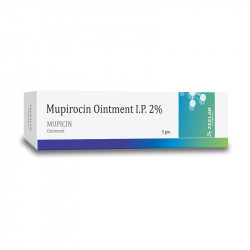Download India's most affordable pharmacy app
- Compare with medicine prices
- Save upto 90% on your medicine bills
COMPOSITION:
Mupirocin (2% w/w)DESCRIPTION:
Mupiban Ointment contains Mupirocin (2% w/w), a topical antibiotic used to treat various bacterial skin infections. It works by inhibiting bacterial protein synthesis, effectively stopping the growth of harmful bacteria. Mupiban Ointment is commonly prescribed for conditions like impetigo, folliculitis, and infected wounds, helping to reduce symptoms such as redness, swelling, and pain while promoting faster healing.
Uses of Mupiban Ointment
Mupiban Ointment is primarily used for the treatment of the following conditions:
- Impetigo (a contagious skin infection that causes sores and blisters)
- Folliculitis (infection of hair follicles)
- Infected cuts, wounds, and abrasions
- Other bacterial skin infections
How Mupiban Ointment Works
Mupiban Ointment contains Mupirocin, which works by blocking bacterial protein synthesis. This action prevents the bacteria from multiplying, allowing the body's immune system to effectively fight the infection. As a result, the infection clears up, reducing symptoms and promoting quicker healing.
Benefits of Mupiban Ointment
The key benefits of Mupiban Ointment include:
- Effective treatment of bacterial skin infections
- Reduces swelling, redness, and discomfort
- Helps wounds heal faster
- Prevents the spread of infection to other skin areas
How to Use Mupiban Ointment
Apply a thin layer of Mupiban Ointment to the affected area 2 to 3 times daily, or as directed by your healthcare provider. Gently massage the ointment into the skin for better absorption. Always wash your hands before and after applying the ointment to prevent spreading the infection. Continue using the ointment for the full prescribed duration, even if symptoms improve before completing the treatment.
Side Effects of Mupiban Ointment
Common side effects of Mupiban Ointment may include:
- Skin irritation, redness, or burning sensation at the application site
- Itching or dryness of the skin
If you experience severe side effects, such as:
- Severe allergic reactions (swelling of the face, lips, or throat)
- Severe skin irritation or blistering
Discontinue use and seek medical attention immediately.
Safety Advice
Before using Mupiban Ointment, inform your doctor if you have:
- An allergy to Mupirocin or any other ingredients in the ointment
- Open wounds, burns, or broken skin (unless advised by your healthcare provider)
Do not apply the ointment near the eyes, mouth, or mucous membranes. In case of accidental contact with these areas, rinse immediately with water. If the infection does not improve or worsens, consult your healthcare provider for further advice.
Frequently Asked Questions (FAQs)
Q: How often should I apply Mupiban Ointment?
A: Apply Mupiban Ointment to the affected area 2 to 3 times a day, or as directed by your healthcare provider. Always complete the prescribed course, even if the symptoms improve before the treatment is finished.
Q: Can Mupiban Ointment be used on the face?
A: Yes, Mupiban Ointment can be used on facial infections. However, avoid contact with the eyes. Always follow the healthcare provider's instructions for sensitive areas such as the face.
Q: How long should I use Mupiban Ointment?
A: Mupiban Ointment should be used for the full prescribed duration, even if the symptoms improve before completing the treatment. This ensures that the infection is fully treated.
Q: Is Mupiban Ointment safe for children?
A: Mupiban Ointment is generally safe for children when used as directed. However, it is important to consult your pediatrician before using it on children under 2 years of age.
Q: Can I use Mupiban Ointment during pregnancy?
A: Mupiban Ointment should only be used during pregnancy if prescribed by a doctor. Always consult your healthcare provider before using any medication during pregnancy or breastfeeding.








 Added!
Added!